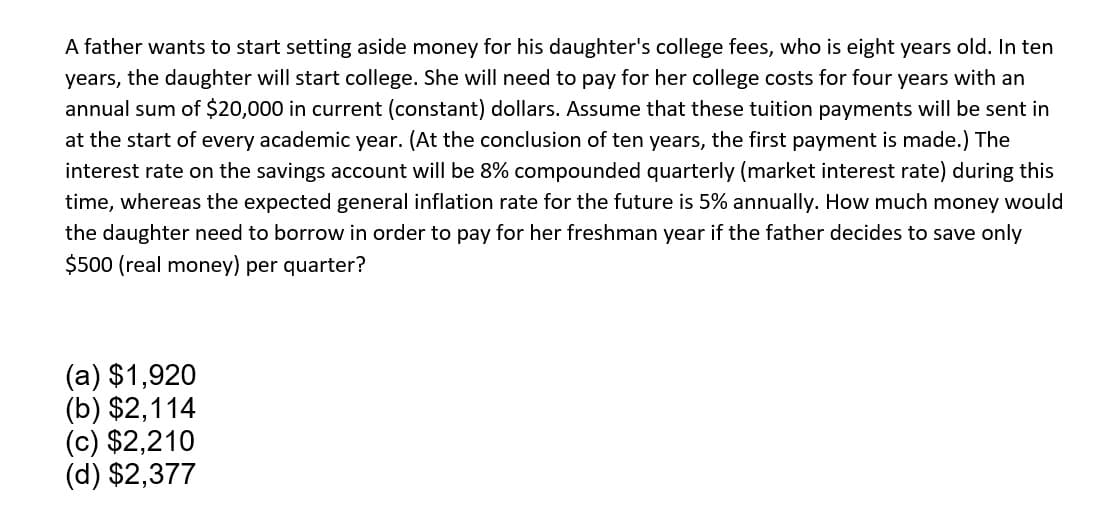A father wants to start setting aside money for his daughter's college fees, who is eight years old. In ten years, the daughter will start college. She will need to pay for her college costs for four years with an annual sum of $20,000 in current (constant) dollars. Assume that these tuition payments will be sent in at the start of every academic year. (At the conclusion of ten years, the first payment is made.) The interest rate on the savings account will be 8% compounded quarterly (market interest rate) during this time, whereas the expected general inflation rate for the future is 5% annually. How much money would the daughter need to borrow in order to pay for her freshman year if the father decides to save only $500 (real money) per quarter? (a) $1,920 (b) $2,114 (c) $2,210 (d) $2,377
A father wants to start setting aside money for his daughter's college fees, who is eight years old. In ten years, the daughter will start college. She will need to pay for her college costs for four years with an annual sum of $20,000 in current (constant) dollars. Assume that these tuition payments will be sent in at the start of every academic year. (At the conclusion of ten years, the first payment is made.) The interest rate on the savings account will be 8% compounded quarterly (market interest rate) during this time, whereas the expected general inflation rate for the future is 5% annually. How much money would the daughter need to borrow in order to pay for her freshman year if the father decides to save only $500 (real money) per quarter? (a) $1,920 (b) $2,114 (c) $2,210 (d) $2,377
Chapter17: Capital And Time
Section: Chapter Questions
Problem 17.7P
Related questions
Question

Transcribed Image Text:A father wants to start setting aside money for his daughter's college fees, who is eight years old. In ten
years, the daughter will start college. She will need to pay for her college costs for four years with an
annual sum of $20,000 in current (constant) dollars. Assume that these tuition payments will be sent in
at the start of every academic year. (At the conclusion of ten years, the first payment is made.) The
interest rate on the savings account will be 8% compounded quarterly (market interest rate) during this
time, whereas the expected general inflation rate for the future is 5% annually. How much money would
the daughter need to borrow in order to pay for her freshman year if the father decides to save only
$500 (real money) per quarter?
(a) $1,920
(b) $2,114
(c) $2,210
(d) $2,377
Expert Solution
This question has been solved!
Explore an expertly crafted, step-by-step solution for a thorough understanding of key concepts.
Step by step
Solved in 2 steps

Knowledge Booster
Learn more about
Need a deep-dive on the concept behind this application? Look no further. Learn more about this topic, economics and related others by exploring similar questions and additional content below.Recommended textbooks for you


Managerial Economics: Applications, Strategies an…
Economics
ISBN:
9781305506381
Author:
James R. McGuigan, R. Charles Moyer, Frederick H.deB. Harris
Publisher:
Cengage Learning


Managerial Economics: Applications, Strategies an…
Economics
ISBN:
9781305506381
Author:
James R. McGuigan, R. Charles Moyer, Frederick H.deB. Harris
Publisher:
Cengage Learning